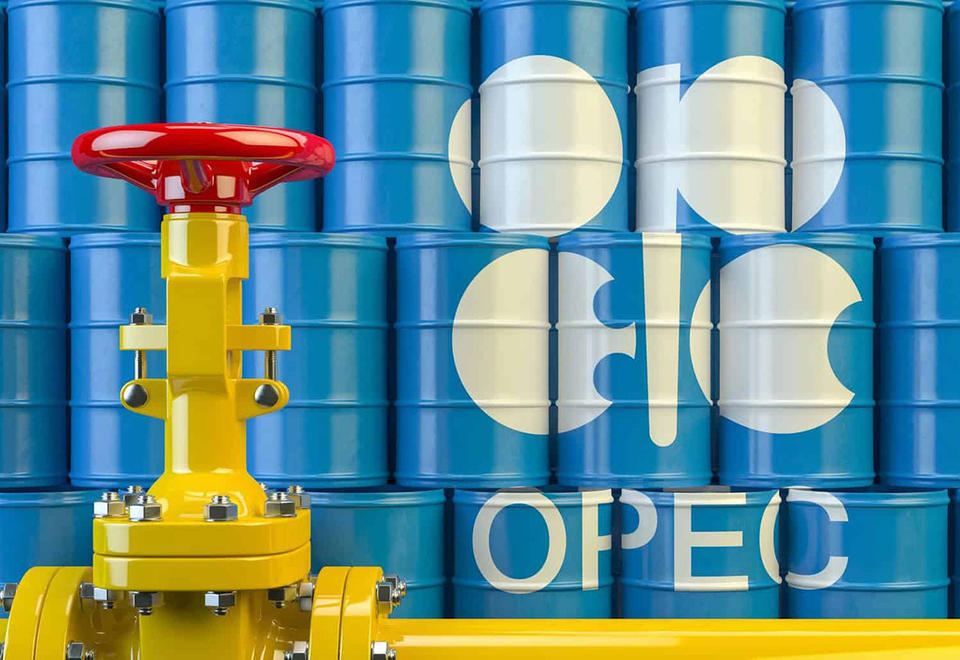Crude Oil Price Movements
Both crude oil spot and futures prices fell for the second-consecutive month in December. Major physical crude benchmarks decreased about 9%, m-o-m, on growing concerns that the rapid spread of the Omicron COVID-19 variant may have an impact on the global economy and oil demand. The OPEC Reference Basket fell $5.99, or 7.5%, to settle at a three-month low of $74.38/b. Crude oil futures prices extended losses in December, declining on both sides of the Atlantic, with the ICE Brent front month down $6.05, or 7.5%, to average $74.80/b and NYMEX WTI declining by $6.96, or 8.8%, to average $71.69/b. Consequently, the Brent/WTI futures spread widened 91¢ to average $3.11/b. The market structure of all three crude benchmarks – ICE Brent, NYMEX WTI and DME Oman – weakened in December, m-o-m. Hedge funds and other money managers extended sharp sell-offs in the first half of December, cutting combined futures and options net long positions related to ICE Brent and NYMEX WTI by about 30% between early November and mid-December.
World Economy
The global GDP growth forecasts for 2021 and 2022 remain unchanged at 5.5% and 4.2%, respectively. The US is estimated to grow by 5.5% in 2021, while growth for 2022 is slightly lowered to 4%. Euro-zone economic growth for 2021 is revised up to 5.2%, while growth for 2022 remains unchanged at 3.9%. Japan’s economic growth forecast for 2021 is revised down to 1.8%, while growth for 2022 remains unchanged at 2.2%. Growth forecasts in emerging economies remain largely unchanged, with China’s forecast at 8% for 2021 and 5.6% for 2022. India’s forecast for 2021 stands at 8.8%, and is forecast at 7% in 2022. Russia’s GDP growth forecast remains unchanged at 4% for 2021 and 2.7% for 2022. Brazil’s economic growth forecast for 2021 is unchanged at 4.7%, while growth for 2022 was revised down to 1.5%. The spread of COVID-19 variants and the effectiveness of vaccines, as well as the pace of vaccine rollouts worldwide, remain key uncertainties. Moreover, supply chain bottlenecks and sovereign debt levels in many regions, together with rising inflationary pressures and the responses of central banks, remain key factors that require close monitoring.
World Oil Demand
World oil demand growth in 2021 is unchanged from last month’s assessment at 5.7 mb/d to average 96.6 mb/d. An upward revision in 4Q21, amid better-than-anticipated transportation fuel consumption in the OECD, was offset by a downward revision in 3Q21 given the latest actual data. Oil demand growth in the OECD is estimated to have averaged 2.5 mb/d and, in the non-OECD region, oil demand growth is estimated at 3.1 mb/d for the year. In 2022, the forecast for world oil demand growth also remains unchanged at 4.2 mb/d, with total global consumption at 100.8 mb/d. In the OECD, oil demand is forecast to grow by 1.8 mb/d, while in the non-OECD oil demand is projected to increase by 2.3 mb/d. While the impact of the Omicron variant is projected to be mild and short-lived, uncertainties remain regarding new variants and renewed mobility restrictions, amid an otherwise steady global economic recovery.
World Oil Supply
Non-OPEC liquids supply growth in 2021 remains unchanged at around 0.7 mb/d, y-o-y, to average 63.6 mb/d. Upward revisions in the US and Kazakhstan were offset by downward adjustments to Brazil, Canada, Ecuador and Norway. The 2021 oil supply estimate primarily sees growth in Canada, Russia, China, the US, Guyana, Norway, Argentina and Qatar, while output is expected to have declined in the UK, Brazil, Colombia and Indonesia. Similarly, the non-OPEC supply growth forecast for 2022 is also unchanged at around 3.0 mb/d, to average 66.7 mb/d. The main drivers of liquids supply growth are expected to be the US and Russia, followed by Brazil, Canada, Kazakhstan, Norway and Guyana. OPEC NGLs are forecast to grow by 0.1 mb/d both in 2021 and 2022 to average 5.1 mb/d and 5.3 mb/d, respectively. In December, OPEC crude oil production increased by 0.2 mb/d m-o-m, to average 27.9 mb/d, according to available secondary sources.
Product Markets and Refining Operations
Refinery margins in all main trading hubs rebounded in December from the downturn seen in the previous month. Margins reached their second highest levels since May 2020 and inched closer to the record highs seen in October 2021. An increasingly tighter product balance in all regions and a pick-up in fuel consumption levels, amid the end-of-the-year holidays, combined to provide positive stimulus to product markets and ultimately led to a robust performance by jet fuel, kerosene and fuel oil, despite a significant rise in global product output levels and rising COVID-19 cases. In addition, strong heating fuel demand, as well as prevailing high gas prices, particularly in Europe, lent further backing to middle distillate markets. In contrast, temporary lockdowns in December exacerbated the seasonal gasoline weakness in the Atlantic Basin, thus limiting further gains in refining economics.
Tanker Market
The long-expected year-end recovery in dirty tanker spot freight rates failed to materialize in December, as lockdowns at the end of the year and softer Chinese buying limited tonnage demand. On average, VLCCs and Aframax slipped 5% and 3%, respectively, m-o-m in December. Suezmax managed a 7% gain over the month before, but remained well below pre-COVID-19 levels. For the year 2021, average VLCC and Suezmax spot freight rates witnessed their worst performance going back more than a decade. Clean rates enjoyed a better performance in December, particularly West of Suez, supported by demand on the Mediterranean routes.
Crude and Refined Products Trade
Preliminary data shows US crude imports edged lower in the final month of the year, but managed to end 4% higher, y-o-y, in 2021, averaging 6.1 mb/d. US crude exports remained below 3.0 mb/d in December and averaged 2.9 mb/d in 2021, representing a 9% decline. The latest data for China shows the country’s crude imports recovered from the low level seen in October to average 10.2 mb/d in November, as state-owned refiners returned to the market. Preliminary data for December shows crude imports increasing further to 10.9 mb/d in the final month of the year. This would result in China’s crude imports in 2021 averaging 10.3 mb/d, down around 5% from the inflated levels seen in 2020 when Chinese buyers snapped up excess volumes in the market. In India, crude imports jumped to a 10-month high in November to average 4.5 mb/d as refiners sought to replenish inventories in preparation for higher runs in 1Q22, following holidays in October and early November. Product exports from India remained steady, averaging 1.3 mb/d in November, as diesel outflows remained strong and jet fuel exports increased, reflecting tightness in the Asian market due to constrained exports from China. Japan’s crude imports jumped in November to the highest since March 2020, averaging 2.8 mb/d, amid higher refinery runs to meet winter heating demand. The latest data shows crude imports into OECD Europe slipped in September, although tanker tracking data shows inflows picking up through November and then easing in December amid lockdown measures.
Commercial Stock Movements
Preliminary November data sees total OECD commercial oil stocks down by 16.0 mb, m-o-m. At 2,721 mb, OECD commercial oil stocks were 389 mb lower than the same period in 2020, 247 mb lower than the latest five-year average, and 221 mb below the 2015-2019 average. Within the components, crude and products stocks fell, m-o-m, by 12.7 mb and 3.3 mb, respectively. At 1,317 mb, crude stocks in the OECD were 143 mb less than the latest five-year average and 137 mb below the 2015-2019 average. OECD product stocks stood at 1,405 mb, representing a deficit of 104 mb compared with the latest five-year average and 84 mb below the 2015-2019 average. In terms of days of forward cover, OECD commercial stocks fell, m-o-m, in November by 0.2 day to stand at 60.7 days. This is 13.2 days below November 2020 levels, 3.6 days less than the latest five-year average and 1.5 days lower than the 2015-2019 average.
Balance of Supply and Demand
Demand for OPEC crude in 2021 remains unchanged from the previous month to stand at 27.8 mb/d, around 4.9 mb/d higher than in 2020. Demand for OPEC crude in 2022 also remains unchanged from the previous month to stand at 28.9 mb/d, around 1.0 mb/d higher than in 2021.
Source: Hellenic Shipping News






